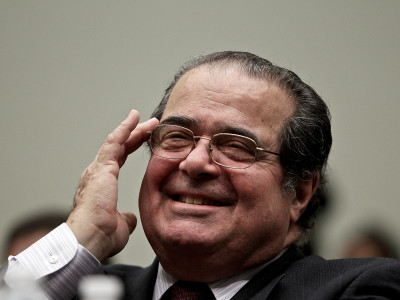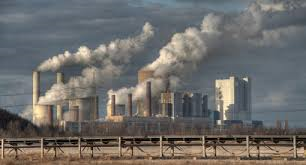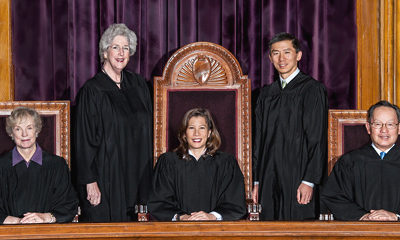General
A Water Rights Database For California’s Future
A proposal to modernize information for management of water resources
In April, a group of us (Richard Roos-Collins, Michael Kiparsky, Nell Green Nylen, Michael Hanemann, and Holly Doremus) wrote a document arguing for the need to develop a more complete and functional source of legal information on California’s water rights. Since then, this proposal has been circulated widely among the California water community. In the spirit of …
Continue reading “A Water Rights Database For California’s Future”
CONTINUE READINGJustice Roberts Relied on Utility Air Regulatory Group in Upholding Obama Subsidies
The Chief Uses Scalia’s Words Against Him and I Can’t Resist Saying “I Told You So”
Today’s opinion in King v. Burwell is a victory for common sense, not to mention for the millions of people who get subsidies under the Affordable Care Act to pay for health insurance. In determining that the subsidies for health insurance extend not only to states that established their own exchanges but also to individuals served …
CONTINUE READINGWhat’s at Stake in Michigan v. EPA, the U.S. Supreme Court Hazardous Air Pollutant Case?
Decision expected in next few days
Although King v. Burwell (the Affordable Care Act case) and Obergefell v. Hodges (the same sex marriage case) are garnering more attention, sometime between tomorrow and Monday the Supreme Court will also hand down its decision in Michigan v. EPA. In the Michigan case, the Court will decide whether EPA’s Clean Air Act rules to regulate hazardous air pollutants …
CONTINUE READINGBreaking News: Supreme Court Rules Federal Agricultural Program a Taking
Justices Uphold California Raisin Growers’ Fifth Amendment Challenge
The United States Supreme Court today ended a David-and-Goliath-style, 10-year legal battle between a pair of California raisin growers and the federal government, declaring that the government triggered a compensable taking of the growers’ private property when a federally-controled agricultural board ordered seizure of a portion of their crop. The Court’s decision can be accessed …
Continue reading “Breaking News: Supreme Court Rules Federal Agricultural Program a Taking”
CONTINUE READINGCalifornia Supreme Court Upholds Affordable Housing Ordinance
Unanimous Court Rejects Developers’ Takings Challenge to San Jose’s Inclusionary Housing Measure
The California Supreme Court, in a unanimous decision issued today, rejected state developers’ efforts to nullify the City of San Jose’s affordable housing ordinance. That decision, California Building Industry Association v. City of San Jose, is critically important for both state land use policy and for constitutional principles governing private property rights and the proper scope …
Continue reading “California Supreme Court Upholds Affordable Housing Ordinance”
CONTINUE READINGBreaking News: D.C. Circuit Dismisses Challenge to Clean Power Plan on Procedural Grounds
But More Challenges Will Follow
The D.C. Circuit Court of Appeals has dismissed the first challenge to EPA’s proposed Clean Air Act Section 111d rule to reduce greenhouse gas emissions from power plants (known as the Clean Power Plan) on the grounds that the rule is only a proposed rule, not a final one. The court’s opinion can be found …
CONTINUE READINGClean Air versus States Rights
A sleeper decision by the D.C. Circuit upholds federal air pollution authority.
The D.C. Circuit’s decision last week in Mississippi Commission on Environmental Quality v. EPA didn’t get a lot of attention, despite having a very significant constitutional ruling. Since the constitutional discussion doesn’t start until about page seventy, after many pages of scintillating discussion of matters like the reliability of private air pollution monitors and the …
Continue reading “Clean Air versus States Rights”
CONTINUE READINGHail to the Chief: John Roberts and the WOTUS Rule
Roberts virtually bemoaned the lack of a rulemaking. Now he’s got what he wanted.
The government issued a long-awaited Waters of the United States rule (WOTUS for short). No doubt there will be much gnashing of teeth about the issuance of the rule — a very safe bet since the gnashers of teeth got going long before the rule was actually issued. But one person who should be happy …
Continue reading “Hail to the Chief: John Roberts and the WOTUS Rule”
CONTINUE READINGAll This, and the Environment, Too?
Israel’s New Government Might De-emphasize Environmental Protection
It’s hardly news that Benjamin Netanyahu’s new government is the most right-wing in the country’s history, stoking dismay in the White House and in the international community. But this hardly implies a lack of environmental concern. Tzachi Hanegbi, Ariel Sharon’s Environmental Protection Minister and a Likud hard-liner, did a professional and highly competent job in …
Continue reading “All This, and the Environment, Too?”
CONTINUE READINGA (Sometimes) Beautiful Equilibrium
John Nash’s contribution to game theory illuminates environmental issues.
John Nash and his wife died yesterday in a cab crash while returning from a trip to Norway to receive a major mathematical prize. He is best known to the public because of the movie “A Beautiful Mind”, which described his struggle with mental illness. His concept of the Nash Equilibrium is basic to a …
Continue reading “A (Sometimes) Beautiful Equilibrium”
CONTINUE READING











